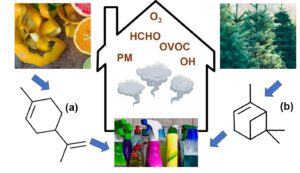Fates and Impacts of Aroma Chemicals in Air
Background
Increasingly rigorous regulation of industry and transportation has led to some air quality improvements, and a changing profile of the volatile organic compounds (VOC) emitted in our towns and cities. 1 Pollution from indoor emission sources is now a significant contributor to the mix of VOC observed in cities such as York. Activities such as cleaning generate high indoor pollutant concentrations as, in addition to active ingredients, household products are routinely dosed with aroma chemicals (AC) to make them attractive to consumers. Toxicity, irritation to eyes or skin and aqueous-phase environmental degradation are assessed when formulating AC mixtures. Evidence shows that secondary products are more harmful to health than primary emissions, yet the breakdown of AC in air and consequent impact on pollution has been largely neglected.

Inexpensive and sustainably sourced, monoterpenes (C10H16) are attractive AC for consumer products, including those marketed as “natural” or “chemical-free”.9 Limonene has a “clean citrus” aroma and is widely used in washing-up liquids and air-fresheners. “Pine-fresh” a-pinene is used in disinfectant, bathroom- and floor-cleaners. Monoterpenes are of low-toxicity, but react rapidly with atmospheric oxidants the hydroxyl radical (OH) and (via the C=C double bond) ozone (O3). Subsequent breakdown in air produces a host of secondary pollutants, including the carcinogen formaldehyde. Alternatives are available, with some in widespread use. However, we simply do not know if they are less reactive (harmful) as we lack the photochemical data from which to make an informed assessment. Many man-made AC are oxygenated VOC (e.g. esters or alcohols), a class of compounds with highly unpredictable chemical behaviour. In this project you will conduct lab- and computational chemistry experiments to discover and assess the impacts of the most important AC on air quality, both indoors and out. The results will improve air chemistry models and inform new AC design, so that benign chemical features can be incorporated into next generation products.
Objectives:
To identify the most commonly used AC in a range of household products; to determine gas-phase oxidation rates and mechanisms for new AC; to assess air quality impacts both indoors and out.
Experimental Approach
In this interdisciplinary project, you will apply a range of experimental, analytical and modelling methods to improve our understanding of AC impacts on air quality. Based in the Wolfson Atmospheric Chemistry Laboratories, you with have access to a range of techniques such as: selective ionisation mass spectrometry and gas chromatography coupled to mass-spectrometry for AC measurements; pulsed laser photolysis for AC breakdown in free-radical reactions; fast-flow reactors for AC photolysis; GAUSSIAN for thermodynamic calculations and chemical structure determinations; INCHEM-py 5 and the master chemical mechanism mcm.york.ac.uk for environmental simulations.
Novelty
This project lies at the intersection of several highly topical research areas, such as air quality, green and environmental chemistry, photochemistry and atmospheric science. Indoor air is a hot topic, and provides opportunities to link with researchers across a wide spectrum of subjects. The Dillon and Carslaw research groups are part of the newly established Built Environment grouping, BE@York. Researchers from across the science departments, from health, social policy, architecture and many other different disciplines meet regularly on campus. We collaborate to address some key societal problems around access to safe, clean spaces in which to live and work. We work with a range of external organisations, including cleaning brand leaders, local and national government representatives and consumer organisations.
Training
You will work with experienced researchers in the Wolfson Atmospheric Chemistry Laboratories and the department of Environment and Geography in York. These laboratories are internationally leading in their respective fields, host large diverse and interdisciplinary science teams and regularly work with key stakeholders such as government, industry, charities and consumer organisations. All necessary technique and skills training will be provided. The York department of chemistry further provides high quality skills training skills and is internationally recognised for supporting diverse researchers.
References
[1] Lewis, (2018), doi.org/10.1126/science.aar4925 ;
[2] Mapelli et al. (2022), doi.org/10.5194/acp-22-14589-2022
[3] Mapelli et al. (2023), doi.org/10.5194/acp-23-7767-2023
[4] Shaw et al. (2023), doi.org/10.5194/egusphere-2023-1328
